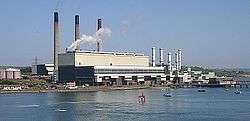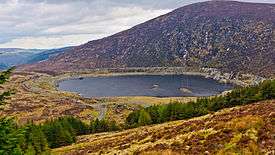Electricity sector in Ireland
The electricity sectors of the Republic of Ireland and Northern Ireland are integrated and supply 2.5 million customers from a combination of coal, peat, natural gas, wind and hydropower.
Island system
|
|
The electricity sector in Ireland previously operated as two separate markets: Northern Ireland operated as part of the UK, and the Republic of Ireland operated its own separate market. On 1 November 2007 the two Transmission System Operators (System Operator Northern Ireland and EirGrid) established the Single Electricity Market (SEM) for the island of Ireland. The SEM has created "a gross mandatory pool market, into which all electricity generated on or imported onto the island of Ireland must be sold, and from which all wholesale electricity for consumption on or export from the island of Ireland must be purchased."[1] According to the Electricity Association of Ireland, in 2013 the Single Electricity Market had approximately 2.5 million customers; 1.8 million in the Republic and 0.7 million in Northern Ireland.[2] The effect of Brexit on the SEM has yet to be defined.
Ireland and Northern Ireland form a regional group of the Europe-wide ENTSO-E organisation. The networks are not yet interconnected with the Continental Europe grid, but have interconnection with the British network through the Moyle Interconnector and the East–West Interconnector. In 2014, the island had an electricity interconnection level (international transmission capacity relative to production capacity) of 9%, below the recommended 10% level.[3]
Electricity in the Republic of Ireland
Electricity generators in the Republic of Ireland are ESB, Airtricity, Synergen (70% ESB), Edenderry Power, Endesa-Ireland and Huntstown (Viridian). ESB owns the transmission and distribution networks.
The Transmission System Operator (TSO) is EirGrid plc, which assumed the role from ESB Networks on 1 July 2006. EirGrid ensures the safe, secure and economic operation of the high voltage electricity grid. EirGrid is owned by the Irish State and is established as a result of a government decision to create an independent organisation to carry out the TSO function, in order to assist the liberalisation of Ireland's electricity industry and the development of a competitive market.
The electricity industry is regulated by the Commission for Regulation of Utilities (CRU) which also regulates the natural gas market. The functions and duties of the CER have been altered and expanded significantly by legislation transposing EU directives into Irish law.
Electricity in Northern Ireland

Electricity is regulated by the Northern Ireland Authority for Utility Regulation. There are three power stations in the province: Ballylumford power station, Coolkeeragh power station and Kilroot power station. Northern Ireland Electricity (a subsidiary of ESB Group) owns the transmission and distribution networks.
The Single Electricity Market means that Northern Ireland Electricity carries electricity on its network in exchange for a regulated charge to the electricity supply company. As of September 2011 domestic customers in Northern Ireland are able to buy electricity from Electric Ireland, Power NI, Airtricity, Click Energy or Budget Energy. Industrial and commercial customers are able to choose from several other electricity suppliers.
The Transmission System Operator (TSO) is System Operator Northern Ireland (SONI Ltd). SONI ensures the safe, secure and economic operation of the high voltage electricity grid in Northern Ireland. SONI's counterpart in the Republic of Ireland is EirGrid. Both of these are owned by EirGrid plc which also (through a partnership of SONI and EirGrid) acts as the Single Energy Market Operator (SEMO), i.e. runs the new all-island wholesale market for electricity.[4]
See also
References
- ↑ http://www.allislandproject.org/en/SEM_overview.aspx
- ↑ EAI, Electricity Association of Ireland. "The Single Electricity Market". Archived from the original on 18 May 2013. Retrieved 22 May 2013.
- ↑ COM/2015/082 final: "Achieving the 10% electricity interconnection target" Text PDF page 2-5. European Commission, 25 February 2015. Archive Mirror
- ↑
External links
- EAI: Electricity Association of Ireland
- Single Electricity Market Operator for the Island of Ireland
- Island of Ireland Electricity Regulation
- Commission for Energy Regulation
- Northern Ireland Authority for Energy Regulation
- Republic of Ireland Transmission Network Operator
- System Operator for Northern Ireland (SONI)
- Republic of Ireland Electricity Suppliers
- Northern Ireland Electricity Suppliers
- Transmission map

